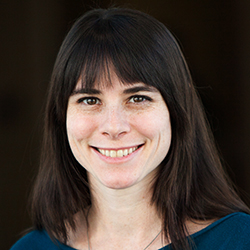Faculty DirectoryNiall Mangan

Assistant Professor of Engineering Sciences and Applied Mathematics
Contact
2145 Sheridan RoadTech, Room M450
Evanston, IL 60208-3109
847-491-7243Email Niall Mangan
Website
Centers
NSF-Simons National Institute for Theory and Mathematics in Biology
Departments
Engineering Sciences and Applied Mathematics
Education
Ph.D. Systems Biology, Harvard University, Cambridge, MA
Dual B.S. Physics and Mathematics, Clarkson University, Potsdam, NY
Research Interests
Data-driven mechanistic modeling for complex systems design
My primary research goal is to connect the speed and automation of top-down data-driven model selection methods with the explanatory power of bottom-up mechanistic modeling. Mechanistic modeling provides a powerful framework for systems design and optimization but relies on the sometimes slow integration of model development and experimental validation. Data science methods promise rapid, automated, descriptions and predictions for complex systems, generally without knowledge of underlying mechanisms. Statistics and information theory allow us to evaluate how well our models describe a system, given the data. By combining methods, I will rapidly develop explanatory mechanistic models and use them to optimize system performance and design engineering solutions.
Data-driven methods for inferring nonlinear dynamics on biological networks.
Inferring the structure and dynamics of biological networks is critical to understanding and controlling their functionality. I am particularly interested in expanding uncertainty quantification methods for dynamical systems to understand increasingly complex metabolic pathways or regulatory elements in a gene network.
Spatial organization in cells to enhance the throughput of biochemical pathways
I am interested in bioengineering spatial organization in bacteria to produce high-value products such as biofuels, alternatives to plastic, and pharmaceuticals.
Systems-level modeling to optimize renewable energy systems.
I am passionate about research that enhances alternative energy. My interest in biological metabolic networks was originally inspired by the potential to bioengineer living bio-fuel factories. I have also worked on design rules for solar cells.
Selected Publications
K .P. Leisman, M. Warns, A. Tiwari, C. Owen, C. Catlett, R. Poretsky, A. Shrestha, A.I. Packman, N. M. Mangan†. A Modeling Pipeline to Relate Municipal Wastewater Surveillance and Regional Public Health Data. Water Research, 252, 121178 (2024).
H. Ribera, S. Shirman, A. V. Nguyen, N. M. Mangan. "Model selection of chaotic systems from data with hidden variables using sparse data assimiliation." Chaos 32, 063101 (2022).
C. Fei, A, T. Wilson, N. M. Mangan, N. S. Wingreen, M. C. Jonikas. "Modelling the pyrenoid-based CO2-concentrating mechanism provides insights into its operating principles and a roadmap for its engineering into crops." Nature Plants. Vol. 8, pg 583-595 (2022)
J. Nyaanga, C. Goss, G. Zhang, H. N. Ahmed, E. J. Andersen, I.R. Miller, J. K. Rozenich, I. L. Swarthout, J. A. Vaughn, N. M. Mangan, S. Shirman, E. C. Andersen. "Changes in body shape implicate cuticle stretch in C. elegans growth control." Cells & Development, Vol 170, 203780 (2022).
N.W. Kennedy, C.E. Mills, C.H. Abrahamson, A. Archer, M.C. Jewett, N.M. Mangan, D. Tullman-Ercek. "Linking the Salmonella enterica 1, 2-propanediol utilization bacterial microcompartment shell to the enzymatic core via the shell protein PduB", Jornal of Bacteriology, e00576-21, 2022.
N. M. Mangan, T. Askham, S. L. Brunton, J. N. Kutz, J. L. Proctor, "Model Selection for hybrid dynamical systems via sparse regression," Proc. R. Soc. London A Math. Phys. Eng. Sci. Vol 475, No 2223 (2019).
N. M. Mangan, S. L. Brunton, J. L. Proctor, and J. N. Kutz, “Inferring biological networks by sparse identification of nonlinear dynamics,” IEEE Transactions on Mol. And Biol. and Multi-Scale Comm. Vol 2, No 1, 2017.
N. M. Mangan*, A. Flamholz*, R. D. Hood, R. Milo, and D. F. Savage, “pH determines the energetic efficiency of the cyanobacterial CO2 concentrating mechanism,” Proc. Natl. Acad. Sci., p. 201525145, 2016. (*authors contributed equally)
Previous positions
- Acting Assistant Professor, Dept. Applied Math at University of Washington, Seattle, WA, 2016-2017
- Research Associate Consultant, Institute for Disease Modeling, Bellevue, WA, 2016-2017
- Visiting Lecturer, School of Engineering, Brown University, 2015
- Postdoctoral Associate, Photovoltaics Research Lab MIT, 2013-2015
AWARDS
- Lynch Foundation Fellowship, 2009
- NSF Graduate Fellowship, August 2008
- Levinus Clarkson Award, May 2008
- Pi Mu Epsilon
- Goldwater Scholarship Award, March 2006